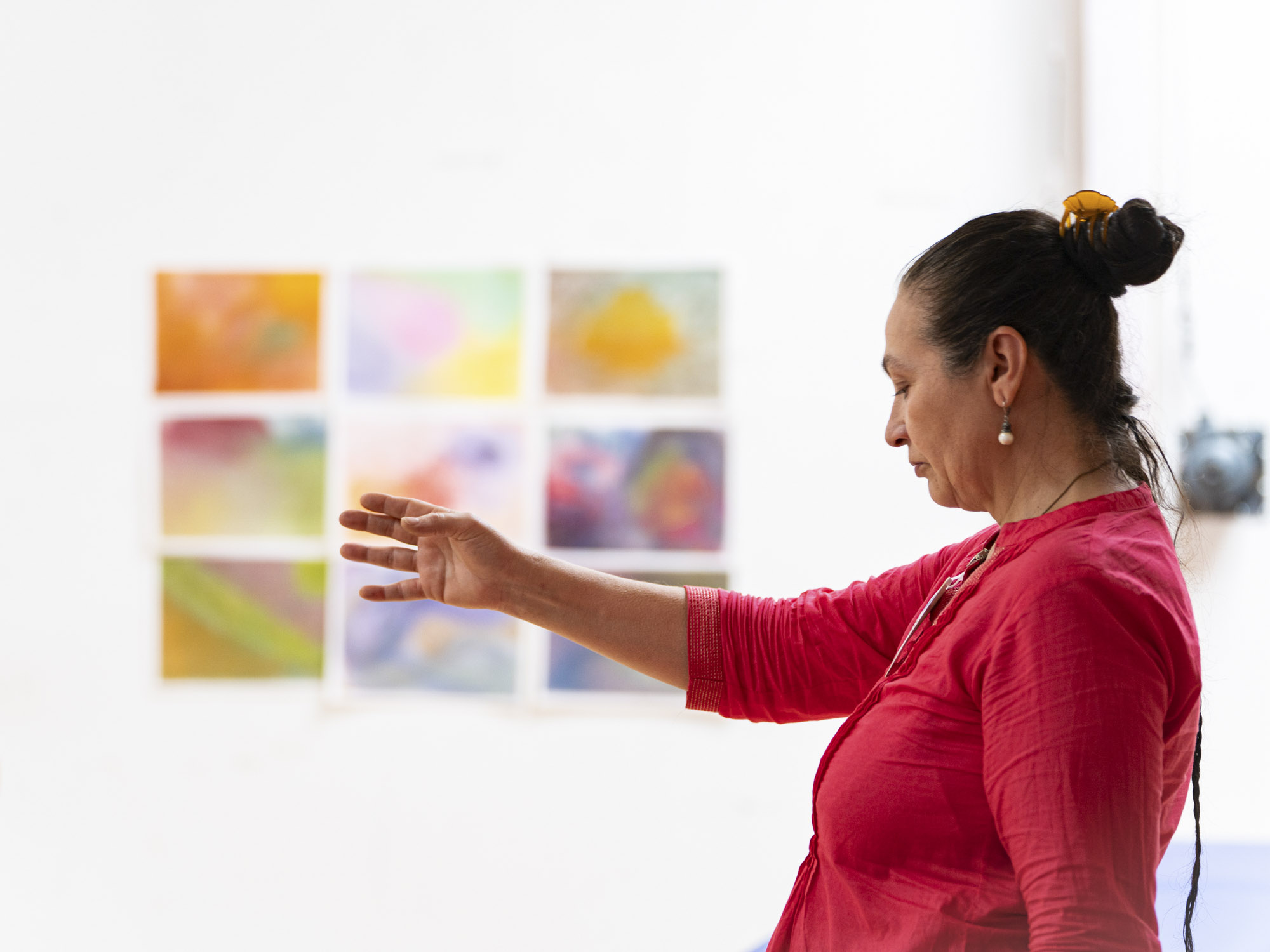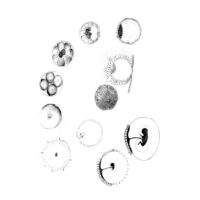Bridging the gap between the I and the body means guiding the higher I into life—a biographical, therapeutic, and Christian task.
Immune cells, which distinguish between what is alien and what belongs to us, mature as T-lymphocytes, or T-cells, in the thymus gland. There, they “learn” to “tolerate” what belongs to the body and only take action against what is “alien.” In these processes of maturation, a subconscious cognition of our own corporeality takes place—”know thyself.” Self-knowledge does not only happen with the question, “Who am I?” in our consciousness, but also in the life sphere of our organism. One of the meditations for young doctors given by Rudolf Steiner describes the two ways the human being can encounter the Guardian, who watches the threshold between the sensory and supersensory world: consciously on the path of knowledge and subconsciously or unconsciously in the sphere of the body, where illness reaches us as a means of redressing karma. The question of self-knowledge is thus anchored in the spiritual and the corporeal and leads to our topic: “How does the spirit form its body and how does the I-organisation work in the body?”
In January 1924, Rudolf Steiner began a series of lectures with the surprising title: Anthroposophy. An Introduction.1 After some 20 years of anthroposophy, it revisits key aspects of this science of the spirit. He begins with two questions: “Who is this human being?”, a motif of “know thyself,” and “What is the origin of this human form?”
To begin with, we are familiar with the relationships between the I-being and its body from everyday life. We can do a lot inwardly and through our lifestyle to make our bodies healthier. We are also familiar with the reverse: changes in the body have an effect on our experience of the I and our mind, which we find in the extent to which our mental state changes when the body falls ill. I was touched when I found an article in a German medical journal stating: “We need the medicine of touch.” The medicine of relationship sounds familiar, but “the medicine of touch” is something else. Here, we can consider the external applications and body-oriented therapies of Anthroposophic Medicine and become aware of how they positively change one’s mental experience in addition to the processes of physical healing. For example, tiredness, nausea, and anxiety are reduced. Here, we experience the interrelationships between the I and the body, but this does not yet take us to the deeper dimension of which Friedrich Schiller speaks: “It is the spirit that builds its body.”2 What is this spirit that forms the body before birth? What is this body that comes into existence at birth?
Rudolf Steiner describes the I experienced in everyday life, in self-awareness or in a sense of self, as a provisional I. Angelus Silesius, theologian and physician, also spoke of this:
In each person rests an image of what they are to be,
until this they become, their peace is not complete.
In every person lives a developmental and future image of what they are to become and not yet are. The spiritual being that we carry within us has not, as yet, entered our earthly life. “I am only an image of it,” says Rudolf Steiner’s meditation on attaining the I. It is a very fragile image, as we know from our everyday lives. But it wants to develop, to come into being. Then it becomes clear: the real being is not to be found “in us” but in the surroundings. It is only reflected in our consciousness as “I-consciousness.” Part of the pictorial nature of our own being is that we experience ourselves as separate from the world and perceive it as a “counterpart.” It is part of the nature of our spiritual being that we are connected with our fellow human beings and our surroundings.
I had the privilege of accompanying a 90-year-old patient to the end of her life. It became clear that we humans not only need physical nourishment but also nourishment of the soul and spirit. So I read to her from the cycle From Jesus to Christ. Then I suddenly saw her lying in her bed as if lifeless, as if not present, as if she had died during the short reading. She was still breathing, however, but seemed to be absent. As I continued reading, she suddenly said, “I didn’t understand that last sentence.” She had been far out in the surroundings, where the human being finds their spiritual home, and came “back” with this surprising remark.
The path to our true being leads across a threshold that is crossed every time we fall asleep. Once, during a lecture, Georg Kühlewind told how, on an evening walk, one of his grandchildren asked him, “When I see the stars, am I with the stars, or are the stars with me?” Our I-being belongs to these stars, and every person belongs to a region of the stars—their spiritual being is connected to the world of stars. When we develop from the provisional I to what we can call the “spiritual I,” we enter realms in which this I-being forms its corporeality, as expressed in the sentence: “It is the spirit that builds its body.”
Every form, including the body form, is a movement that has come to rest. In embryology, we see how slow movements give rise to forms. Every form is preceded by a movement, and every movement carries wisdom within it. What wants to take form reveals a comprehensive wisdom that we marvel at in the human organism, for example. Wisdom, movement, and form work in the development of the body and lead to the corporeality of the human being.
But development and change are also part of the body. We are not always one and the same “image”—there is transformation. Some of the body’s shapes, such as the shape of the ear, remain largely unchanged during life, carrying their prenatal shape through life. Other body shapes, such as the face, show major changes. We possess a general human form and individualise it according to our being. “From my head to my feet, I am the image of God,” says a children’s prayer by Rudolf Steiner. This image is individualised: “Right down into the smallest parts of their substance, human beings are the result of this I-organisation,” as Rudolf Steiner and Ita Wegman put it. The archetype of the human body, this “first draft of God” (Friedrich Schiller),3 is also connected to the world of stars. In the Goetheanum, the blue window in the Main Auditorium shows how the human form relates to the zodiac. In Scorpio and Eagle, we can recognise the nervous and sensory system, in Leo, the heart forces, in Taurus, the metabolic and limb system. They are all harmoniously connected by the constellation of Aquarius.
I-Development and Body Formation
We can ask in two directions: How does the “provisional” I of the everyday world of consciousness develop into the true I that is connected to the world of stars? And how does the body develop into what underlies it as the “first design,” that is, as the archetype of the body form?
Here, we are referred to the pre-natal stage, where the human being forms the individual body form, the spirit body, together with hierarchical beings and with other human beings. The body form is created that corresponds to the true I-being of a person. When spirit and body are harmoniously joined in incarnation, the result is health; otherwise, the body can become alien to the person, as we find in many of the increasingly common autoimmune diseases.

The I-Organisation in the Skeletal System and in the Blood
The embryonic tissue (mesenchyme, from Greek: middle infusion) originates mainly from the middle germ layer, the mesoderm. Characteristic structures such as the “Chorda dorsalis” can be found there, which in humans is associated with the uprightness of the spinal column as the central quality of the I-organisation. The bones and connective tissue, that is, the tissues that determine our form, are further formed from this mesenchyme. In addition to these “formative tissues,” the muscles and blood also develop from the mesenchyme. A polarity thus emerges in the formation of the body: the tissues of form and the tissues of movement. In An Occult Physiology, Rudolf Steiner, in 1911, speaks about the I-organisation. The I-organisation reveals itself unconsciously in the bones, and thus in the individual form of the body, and acts as the “conscious I-organisation” in the blood.
The human being’s I-being, which “builds its body,” fashions the shape of the body and works with its willpower in the blood and muscles. When the I inscribes itself into the body like a thought, form emerges. When the I works with willpower, the dynamic of the blood and the moving musculature develops. A polarity spans the form-bearing tissues and the moving tissues, which are connected by a metamorphosis.
Nervous and sensory system – skeletal system – connective tissue – muscles – blood.
Metabolic and Limb System
Rudolf Steiner describes the relationship between form and movement as “ideational metamorphosis.” There are “real metamorphoses,” for example, when a leaf develops and changes its leaf shape visibly, and “ideational” ones, where, even though the intermediate stages do not emerge directly from each other, there is a spiritual connecting principle—like in the sequence of leaves on the stem of a plant. Blood and the skeletal system are related to each other through such an “ideational metamorphosis.” The I-organisation lives in warmth. Everything it accomplishes in the metabolism and in movement is linked to warmth processes. Bone, on the other hand, has a mysterious relationship with light and appears like a light shape made visible. Its high phosphorus content (“phosphorus” means light carrier)—we have about 0.7 kilograms of phosphorus in our body—permeates the skeleton as a light form. Thus, a metamorphosis spans our threefold organism, which extends from the skeletal system via the connective tissue and muscles to the blood and can become the site of important autoimmune diseases. If the body becomes “alien” here, rheumatic diseases, connective tissue diseases, vasculitis and thus the main spectrum of autoimmune diseases in humans develop.
Why does the body then become “alien?” Why do autoimmune diseases manifest themselves? In current medical research, psychosomatic factors are also known to be involved in autoimmune diseases.4 They illuminate the relationships between the soul, the spirit and this alienation of the body. We can understand them through the action of the constitutional elements in the formation of the body.
In the first seven years, the etheric acts in the generative processes of body formation. Then, these life forces metamorphose into forces of thinking. The child grows ready for school. The astral body carries out a corresponding activity in the second seven-year period. Here, it first acts in the bodily realm, allows the changes in the body’s form to develop and is then “born” in the third seven-year period. The human I also first unconsciously shapes the body in order then to be able to develop self-efficacy at the age of 20 or 21.
When the Body Turns Alien
In the case of the constitutional elements, we must always distinguish between body-oriented action and action that is detached from the body. On the one hand, the human being’s constitutional elements work to form the body, as they do every night with their restorative regeneration processes. On the other hand, they turn towards conscious activity while awake. It is a constant rhythm between the organic creativity of the constitutional elements and their orientation towards the world of consciousness. Trauma and shocks can tear the constitutional elements out of their generative bodily activity and force them to “awaken” too early. The body is then not sufficiently formed and thus becomes “alien.” Today, we know about the effects of childhood trauma—the epigenetic consequences with effects on health in later life. Rudolf Steiner pointed out the significance of traumatising experiences in childhood and adolescence for later life more than 100 years ago. These connections are now becoming increasingly recognised and a key part of therapy.
If the body becomes alien in this way, causes of autoimmune diseases can arise. They develop a field of tension between inflammatory and sclerosing forces. Scleroderma, for example, which affected Paul Klee, leads to processes of sclerosis in the organism. Conversely, we are familiar with systemic lupus erythematosus with pronounced inflammation and fever. In these autoimmune diseases of the connective tissue (collagenoses), the spectrum spans hardening and dissolving-inflammatory disease processes. Recovery means a struggle for the middle, for the balance between these polarities.
The muscles can also develop autoimmune diseases, and we are familiar with autoimmune diseases of the blood vessels (vasculitis) and even of the blood cells (haemolytic anaemia, antibodies against the blood platelets). If the I cannot connect sufficiently with the body but is disrupted in its “construction work,” tissues and organs can become alien. Here, there are genetic predispositions that do not necessarily lead to the disease but require further factors, including psychosomatic ones.
Autoimmune Diseases against the Background of the Threefold Structure of the Human Organism5
How can we now support the constitutional elements and thereby make the body familiar again? In addition to therapeutic measures, inner spiritual activity—”meditation on patients”—plays an important role because “it is the spirit that builds its body.” When we read verses and meditations to patients during the consultation and write them down for them, the immediate reaction can sometimes be seen on their faces: it is often an expression of deep understanding, sometimes a happy smile, even tears of emotion. The following meditation connects with the sun forces and the warmth of the world:
In my heart
Shines the power of the sun
In my soul
The warmth of the world is at work.
I want to breathe
The power of the sun
I want to feel
The warmth of the world.
Let the power of the sun fill me
Let the warmth of the world penetrate me.6
Through this inner work, the uprightness returns—new perspectives and viewpoints can light up in the soul. If, inspired by inner spiritual work, a new light is kindled on a morning, then perspectives about the future that take on a meaningful significance in which patients can believe may become visible.
When stress and doubt weaken the forces of the soul, new aspects and perspectives awaken confidence and nourish the soul. This is why the astral body is not only called the soul body, but also the “belief body” [Glaubensleib] because new viewpoints, values, and guiding convictions strengthen the soul.
Illness very easily leads to loneliness—we are alone with our ailments. If a therapeutic relationship then develops in which forces of love and warmth arise, this strengthens the etheric organisation, the life body. In Paracelsus’ sense, this love is the “greatest medicine” and strengthens the healing forces of the etheric body, which is therefore also called the “love body.” Hope can develop from the new perspectives and take on a crucial role in the course of the illness. The forces of hope work right down to this physical level, which is why Rudolf Steiner also refers to the physical body as the “hope body.”
It was not without reason that I mentioned reading from Rudolf Steiner’s From Jesus to Christ to this elderly patient. Steiner’s line of thought reminds us that the path to recovery we are discussing here is connected to the Mystery of Golgotha. This path is linked with a profound Christological dimension. Rudolf Steiner describes the spirit body as having a healthy disposition, but that it has been damaged and weakened by our coexistence with the earthly world, with everything that affects our being luciferically and that leads us into materiality. Now this spirit body arises in a new form through the Mystery of Golgotha and becomes the basis for the healthy formation of the body.
On the other hand, the Mystery of Golgotha is linked to the development of the human I. In the first edition of The Calendar of the Soul in 1912, it says: “In the year 1879 after the birth of the I.” So, both the development of the I and the development of the body as the temple of the I-being are connected with the Mystery of Golgotha. The forces of healing lie in the archetypal image of the Christ event. Novalis finds the following words for this:
The heart is the key to the world and to life. One lives in this helpless condition in order to love and be beholden to others. Through imperfection, one becomes open to the influence of others. And this influence of others is the purpose. In illness, only others ought and can help us. Thus Christ, from this point of view, is indeed the key to the world.7
Translation Christian von Arnim
Title image During the workshop: Creating Bridges between Osteopathy and Art as Prevention and Treatment of Autoimmune Diseases through a Fourfold View of the Human Being (EN/ES); Photo: Xue Li
Footnotes
- GA 234; see The Rudolf Steiner Archive.
- From: Friedrich Schiller, Wallenstein (trilogy), Death of Wallenstein, Act 3, Scene 13.
- Friedrich Schiller, Erzählungen [Stories], Sämtliche Werke, Volume 5, p. 344 (Munich: Hanser, 2008).
- Kassem Sharif et al., “The Role of Stress in the Mosaic of Autoimmunity: An Overlooked Association” in Autoimmunity Reviews 2018 Oct;17(10):967–983.
- From: Matthias Girke, Innere Medizin. Grundlagen und therapeutische Konzepte der Anthroposophischen Medizin [Internal Medicine. Foundations and therapeutic concepts of Anthroposophic Medicine], 3rd edition (Berlin: Salumed Verlag, 2020).
- From: Rudolf Steiner, Mantric Sayings: Meditations 1903–1925 CW 268 (SteinerBooks, 2015).
- See Philosophical Writings.





